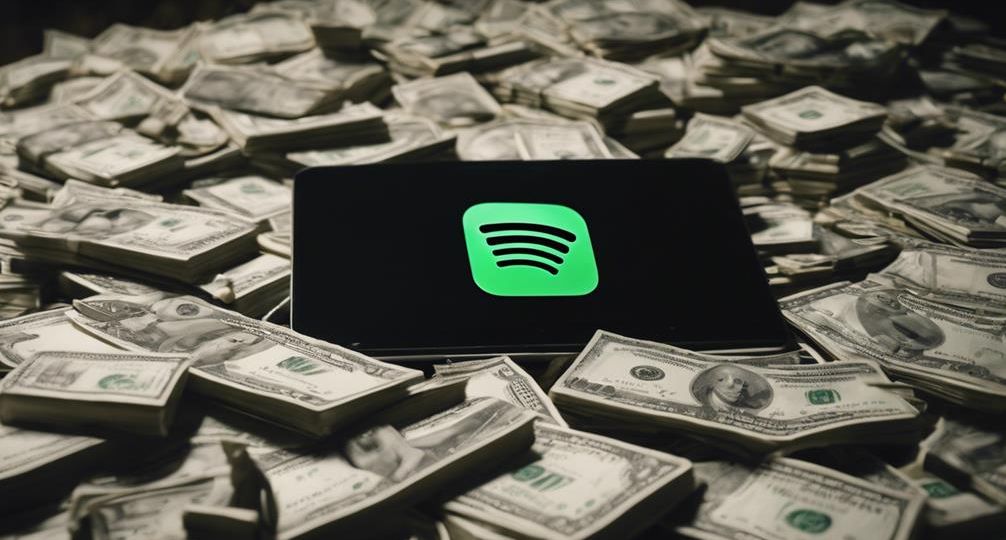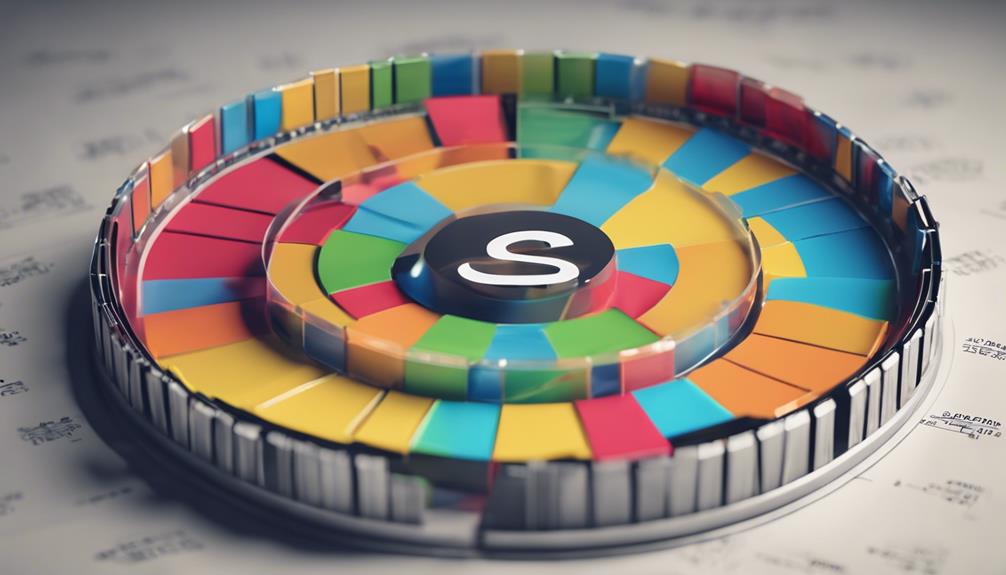
How many Spotify plays for $1000 dollars?
Spotify’s royalty calculations can be intricate, but on average, you’ll need between 200,000 to 333,333 plays to earn $1,000. This figure considers the platform’s typical payout per stream, which ranges from $0.003 to $0.005. Various factors can influence your actual earnings, such as the listener’s country, subscription status, and your share of total streams. Playlist placements and fan engagement can greatly boost your plays and revenue. Navigate this web of considerations with ease, and efficiently monetizing your music on Spotify becomes a more achievable goal. Carry on exploring here, and you’ll uncover an array of more useful insights.
Key Takeaways
- Spotify’s average payout per stream ranges from $0.003 to $0.005.
- Earning $1000 requires approximately 200,000 to 333,333 plays on Spotify.
- Royalties are influenced by factors such as territory and listener’s subscription status.
- Pay rates may vary due to negotiations between Spotify and rights holders.
- Playlist placements and fan engagement can significantly increase play count and earnings.
Understanding Spotify’s Payment System

To truly understand how Spotify pays for plays, you need to explore the intricacies of their unique payment system. Unlike traditional models, Spotify doesn’t pay a fixed price per play. Instead, they use a pro-rata model, which means the total revenue is divided amongst all played tracks based on their proportion of total plays. This model has been a core point in royalty disputes between artists and Spotify.
You see, Spotify operates on two subscription models: free and premium. Revenue from ads and subscriptions is pooled together, forming a royalty pot. This pot is then divided amongst rights holders based on the share of total streams their music represents. The more plays you get, the larger your slice of the pie.
However, the system isn’t as straightforward as it sounds. There’s a complex algorithm that considers factors like the listener’s country and subscription status. This means a play from a premium subscriber in a high-income country has a higher value than a play from a free user in a low-income country.
Understanding these nuances can help you navigate the tumultuous waters of Spotify’s payment landscape.
Breaking Down Music Streaming Royalties
You’re probably wondering how music streaming royalties are calculated.
It’s essential to grasp the intricacies of Spotify’s payment rates, as they directly impact an artist’s earning potential on the platform.
Understanding Music Streaming Royalties
Exploring the intricate world of music streaming royalties, it’s vital to realize that each play on platforms like Spotify generates a small amount of revenue for the artist. Royalty disputes often arise, especially among independent artists, as the system can appear complex and opaque. It’s important to understand that streaming platforms pay royalties based on a pro-rata model.
In this model, the total revenue of the platform is divided among all the streamed tracks proportionately. Imagine a pie, where each slice represents the share of total streams an artist has received. The size of your slice, or royalty, depends on how many plays your tracks get compared to others. So, it’s not just about how many times your song is played, but also how it performs relative to other tunes.
Moreover, it’s crucial to realize that your slice of the pie is also influenced by the listener’s subscription type and their location. Premium subscribers generate more revenue per stream than free users, and streams from developed countries pay more. It’s a multifaceted system that requires a keen understanding to navigate successfully.
Calculating Spotify’s Payment Rates
Now that you’ve got a handle on the pro-rata model and its influence on music streaming royalties, let’s get down to the nitty-gritty of how Spotify calculates its payment rates.
To be clear, there isn’t a flat rate per stream. Instead, Spotify’s royalty distribution is based on two key factors: your stream share and the total revenue Spotify has generated.
Stream share refers to the percentage of total streams on Spotify that your music accounts for in a given territory, during a given time period. The more you’re streamed, the higher your stream share. It’s a dynamic metric, affected by things like new releases and promotional activity.
Total Spotify revenue is the sum of all premium subscriptions and advertising revenue generated in that territory during that time period. It’s influenced by the number of users and their listening habits.
These two factors are then fed into Spotify’s complex streaming algorithms to calculate your royalty payment. It’s a dynamic process that adjusts for factors like market fluctuations and exchange rates, ensuring that your payment is as important and accurate as possible.
Understanding this process is essential in maximizing your Spotify royalty earnings.
Earning Potential on Spotify
Exploring the potential earnings from Spotify, it’s essential to understand how music streaming royalties are broken down and the various factors that can impact your income. Spotify calculates your royalties based on the total number of streams, the location of those streams, and the type of account used by the listener.
Spotify’s demographics are pivotal in determining your earning potential. Different countries have different royalty rates, and the more listeners you have in high-royalty countries, the more you earn. For instance, streams from a premium user in the US will generally generate more income than streams from a free user in a lower-royalty country.
Playlist promotions can also significantly boost your income. If your music gets added to popular playlists, it can greatly increase your exposure and streams, thereby increasing your revenue.
However, it’s noteworthy that Spotify also deducts a certain percentage as its commission. Understanding these elements can help you strategically increase your earning potential on Spotify, but remember that it’s not just about the number of plays, but also about where and how those plays are made.
Factors Influencing Spotify Payout

Understanding the various factors that influence Spotify’s payout can greatly impact your earnings as an artist on the platform. Two major elements you need to take into account are streaming algorithms and royalty negotiations.
Streaming algorithms are the sophisticated software tools Spotify uses to track and calculate the number of plays for each song. They’re not just counting the number of times a song is played, they’re also analyzing the listener’s behavior, location, and even the time of the day. This data-driven approach guarantees more accuracy but also adds to the complexity of understanding your potential earnings.
Royalty negotiations also play a significant role in determining your payout. These are agreements between Spotify and music rights holders, often involving intricate calculations and various factors such as territory, artist popularity, and the listener’s subscription type.
You should know that Spotify doesn’t pay a fixed rate per stream; it’s a pro-rata model, meaning your earnings depend on the total number of streams on the platform.
Calculating Spotify Plays for $1000
Crunching the numbers to determine how many Spotify plays you need to earn $1000 can seem like a challenging task, given the platform’s complex payout structure. But, with a bit of analysis, you can get a clearer picture.
Spotify’s average payout per stream ranges from $0.003 to $0.005. This means, to make $1000, you’d need between 200,000 to 333,333 plays. However, this isn’t a concrete number. The actual amount depends on various factors, including playlist placements and regional breakdown of listeners.
Let’s break it down:
| Factor | Influence |
|---|---|
| Playlist Placements | Playlists drive discovery and plays. A popular playlist placement can significantly increase your streams. |
| Regional Breakdown | Spotify pays differently based on the listener’s location. More plays from regions with higher payout rates can boost your earnings. |
Case Studies: Spotify Play Earnings

Now, let’s turn your attention to some real-world examples to further understand Spotify play earnings.
You’ll assess Spotify’s payment structure, scrutinize the actual earnings of musicians, and evaluate the impact of plays on those earnings.
Analyzing Spotify’s Payment Structure
Diving deep into Spotify’s payment structure, you’ll uncover a complex web of factors that determine how much artists earn per play. It’s not as straightforward as one might think, with streaming challenges and royalty disputes often muddying the waters.
Spotify calculates its royalty payouts using a pro-rata model. This system pools all the revenue generated from ads and subscriptions, then divides it based on the share of total streams an artist has. It’s about market share, not a flat rate per stream. This means that big artists with millions of streams often get the lion’s share of the revenue.
Royalty disputes often arise because of this model. Some artists argue it’s unfair, favoring popular music over niche genres. They believe a user-centric payment model, which allocates royalties based on individual listener’s habits, would be more equitable.
Furthermore, the streaming challenges posed by bots and fraudulent plays can also impact an artist’s earnings. Spotify uses advanced algorithms to filter out these false plays, but it’s an ongoing battle.
In the end, the number of plays needed to earn $1,000 depends on these intricate calculations and prevailing market conditions.
Real-life Musician Earnings
Often, examining real-life case studies of musician earnings from Spotify plays can offer valuable insights into the practical workings of the platform’s complex payment structure. Musicians, whether indie artists or industry bigwigs, are maneuvering through this digital landscape to maximize their earnings.
Take the case of an emerging indie band, for instance. Their Spotify streams mightn’t be their primary revenue source, but it’s an integral part of their income ecosystem. Each play translates to a fraction of a cent, which may seem minor but can accumulate notably over time.
Now, consider concert promotions and merchandise sales, both vital components of a musician’s financial strategy. A popular track on Spotify can drive ticket sales for live performances, enhancing concert promotions. Similarly, increased visibility on the platform can boost merchandise sales as fans connect more deeply with the music and the artist.
However, it’s important to note that these earnings aren’t evenly distributed amongst all musicians. Spotify’s payment model favors those artists with massive followings. Therefore, the platform can be seen as a place that amplifies existing success rather than a venue for discovering breakout artists.
The platform’s payment structure, while innovative, poses a challenge for musicians seeking to maximize their earnings.
Impact of Plays on Earnings
Understanding the impact of plays on earnings through specific case studies provides a concrete view of how Spotify’s payment model functions in practice. Streaming economics isn’t a simple game of more plays equating to more money. It’s a complex system that takes into account multiple factors.
Consider the royalty distribution process. Spotify doesn’t pay artists directly per stream. Instead, it allocates around two-thirds of its total revenue to rights holders, including labels, publishers, and independent artists. This pool of money is then divided based on the proportion of total streams each artist holds.
For instance, if your song garners 0.5% of all Spotify streams in a given month, you’d receive 0.5% of that month’s royalty pot.
Here’s where it gets tricky: if Spotify’s revenue fluctuates, so does the size of the royalty pot, and subsequently, your earnings.
Maximizing Your Spotify Revenue
For optimizing your Spotify revenue, it is essential to strategize your music promotion, leverage playlist placements, and cultivate a strong listener base. Playlist strategies play a significant role here. By securing slots in popular playlists, your music can reach a broader audience, thereby increasing plays and revenue.
Fan engagement is another key aspect. Interacting with your listeners, responding to their comments, and acknowledging their support can foster a loyal fanbase. Loyal fans are more likely to stream your music regularly, which directly impacts your earnings.
Consider the following table to understand some effective revenue-maximizing strategies:
| Strategies | Impact |
|---|---|
| Playlist Placements | Increases visibility and reach |
| Fan Engagement | Fosters loyalty and regular streams |
| Music Promotion | Raises awareness and attracts listeners |
| Strong Listener Base | Guarantees a steady revenue stream |
Future of Spotify and Music Streaming

Picturing the future of Spotify and music streaming, it’s clear that new technologies and evolving listener habits will dramatically reshape the landscape. Subscription model evolution is likely to drive this change, as users demand more value for their money. You might see Spotify experimenting with tiered pricing, offering exclusive content or personalized experiences to premium subscribers.
Artificial Intelligence (AI) also plays a pivotal role in this evolution. Imagine AI-generated music tailored to your mood, your activities, or even your heart rate. With AI, Spotify could create unique, personalized soundtracks for your life, revolutionizing the way you consume music.
But AI’s impact extends beyond just creating music. It could redefine discovery algorithms, making them more intuitive and responsive. The potential is endless – from algorithms that learn your musical taste more accurately, to those that predict trends, giving you a taste of the ‘next big thing’ before it explodes onto the mainstream scene.
Innovation in music streaming lies at the intersection of technology and user experience. While it’s tough to pinpoint exactly how Spotify will evolve, one thing’s certain – it’s poised to push the boundaries of what’s possible, shaping the future of how we experience music.

